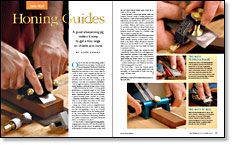Honing Guides
A good sharpening jig makes it easy to get a fine edge on chisels and irons

Synopsis: Honing guides can streamline the task of sharpening chisels and plane blades so you can get back to the workbench. Cliff Colley tests eight types of sharpening guides, ranging in price from $9 to $70, to see which have the most convenient features and are easiest to use. Brands tested include the FasTTrak, General 809, Kell, Sharpening Sled SS1, Stanley, Veritas and Veritas Mk.11, and inexpensive single roller guides available from a range of manufacturers. Find out which guides Colley likes best, and which one he picks as best value.
One of the first woodworking skills I learned from my father was the art of sharpening plane blades and chisels by hand. I became convinced that freehand sharpening was the only way to put a keen edge on a tool. It wasn’t until I started my first job in a cabinet shop at 15 that I learned otherwise. One day, my boss saw me honing a 1⁄2-in. chisel by hand. He tossed me a honing guide and said, “Use this. It’s consistent and faster.”
He was right. In minutes, I was back at the workbench, putting a perfectly honed tool to wood.
Unlike sharpening by hand, a honing guide guarantees a consistent angle as you work your way up through the various grits, which makes sharpening faster and more efficient. A typical honing guide consists of a body, a clamping mechanism to hold a blade, and a roller or set of rollers that rides on the stone or on a surface adjacent to the stone.
Using one of these tools is straightforward. After lapping the back of the chisel or plane iron flat and grinding a bevel on a bench grinder, mount the blade in the honing guide, set the bevel angle, clamp down the blade, and roll it across whatever sharpening medium you prefer (waterstones, oilstones, diamond plates, or sandpaper on glass).
For this review, I tested eight honing guides, ranging in price from $9 to $70 (for the rundown on each tool, see pp. 40-41). In general, most of the guides I looked at are easy to use, and all can hold typical blade sizes, from 1⁄8 in. wide to 27⁄8 in. wide.
From the tests, I found that guides with convenient features made a lasting impression. For instance, a few of the honing guides have adjustment mechanisms that allow you to put a secondary bevel (also called a microbevel) on a blade. Without this feature, you’d have to unclamp and slide the blade back about 1⁄8 in. A secondary bevel is steeper than the primary bevel and makes for a beefier edge that is easier to touch up later.
Some of the guides also come with angle-setting gauges either built in or as separate components. Finally, honing creates a burr on the back of the blade, which should be removed before you put the blade to use. A few guides allow you to remove this burr while the blade is mounted in them.
From Fine Woodworking #179
For the full article, download the PDF below:
Fine Woodworking Recommended Products

Olfa Knife

Starrett 4" Double Square

Stanley Powerlock 16-ft. tape measure







Log in or create an account to post a comment.
Sign up Log in